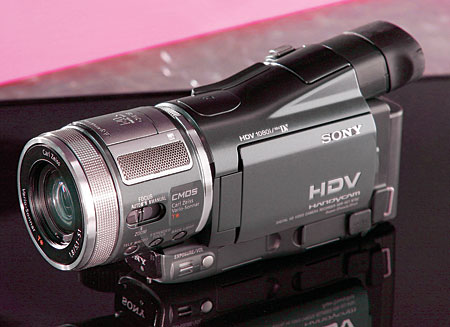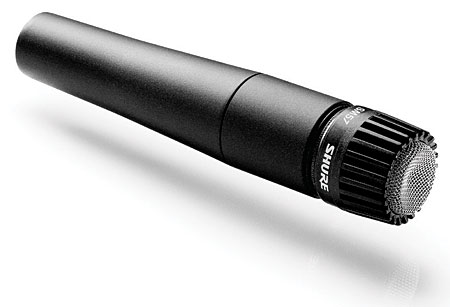Make HD Movies
Buy a tripod. That is my sagelike advice after three (admittedly terrible) student films and just enough film school to ruin movies for me forever. Once you have a tripod, things become much easier.
The Camera
There are a handful of HD cameras on the market today. The newest is the Sony HDR-HC1. Unlike Sony's previous HD camera, this one uses a single CMOS chip to capture an image. CMOS and CCD (the more familiar image-capture sensor) go about their business in slightly different ways. In a CCD (charge-coupled device), each pixel changes a photon to an electron and sends it along off the image sensor. The camera then converts the electron to voltage and sends it to a separate processing chip. Here, the camera converts the voltage to digital and further processes it to eventually produce a single frame (or field) of video.

On a CMOS (complementary metal-oxide semiconductor) chip, just about all of the above steps take place on the single chip. Historically, CCD technology was known for having better image quality at the expense of battery life, compactness, and cost, while CMOS chips were known for, well, the exact opposite. Nowadays, the line between the two technologies is a blurry one. You can find CMOS-based cameras with excellent image quality, inexpensive CCD-based cameras, and so on. As it happens, the HDR-HC1 has a single CMOS chip and, at $2,000, is about $1,700 cheaper than its three-CCD-based big brother, the HDR-FX1.
Preproduction
As I said, buy a tripod. Sure, handheld camera antics are all the rage in movies (The Bourne Supremacy being a notable offender), but, in home movies, this technique is more nauseating than artsy. Be that guy—bring a tripod wherever you can. Anyone you subject to watching your movies will thank you.
The question of why to shoot in HD has several obvious answers (because it's cool!), so the better question is why not to shoot in HD. Storage space is one. The tapes that work with the HDR-HC1 camera store about an hour each, which is a fairly standard capacity. Once you get the video off the tape and onto your computer, it's a different story. The 1080i footage will take up many, many gigabytes. You'll probably need to get a new hard drive. To compound that, you have fewer places you can dump the footage off to after you're done editing. Also, you can't just put the footage onto a DVD and send it to your parents (unless you downconvert it to NTSC, but doesn't that defeat the purpose?). Of course, if your parents have an HDTV and an HTPC, that's a different story. Let's forget about all that for now and concentrate on how cool it is to make your own HD movies.
Production
Once you have your actors assembled, get your tripod set up. Your footage will look and sound quite different depending on where you shoot. If you're far away, say at the back of an auditorium, you'll have to zoom in to the action. This will flatten everything out, smooshing your subjects into the background. This isn't necessarily a bad thing. Legendary director Akira Kurosawa would shoot with a telephoto lens because he liked how it flattened everything out. By contrast, if you're up close, you'll have to pull the zoom lens wide. This brings your subjects out and separates them from the background. Want to make your child the star? Film up close with a wide angle, and the rest of the production will be background. Of course, don't get too close with a wide angle, as that makes everyone look fat and weird (like the close-ups in any Wes Anderson movie).
Your positioning will also affect the sound. From the back of an auditorium, the sound will be echoey and tinny. If you shoot from the audience, you run the risk of not hearing anything but coughs, cell phones, and applause. Then again, if your child's recitals are anything like mine were, this is probably a good thing. Look, you've got the tripod and the HD camera; why not bring it to the next level. Many school productions will have a mixing board to make sure the mike levels are set correctly. Get there early, bring your own cables, and jack in. It may take a bit of research to get the correct adapters from the mixing board to your camera, but the sound will no doubt be a lot better. Just make sure you test it before the performance starts to see if it all works.
If you really want to embarrass your kids (you know you do), and your camera supports it, buy a microphone and set it up near the stage/performing area (a Shure SM57 is an excellent cheap mike). There are literally volumes of text on mike placement. If you go this route, check out what the experts say. Get there early to set up, and, most importantly, stay out of everyone's way. Who knows: If you do a good enough job, maybe you can be the cameraman for future performances. (Think...$10 per copy.)
If you take your camcorder on vacation, there's a different set of rules to follow. For the love of all things holy, pan slowly. Fast pans would make Chuck Yeager boot. Unfortunately, no one and nothing will wait for you to set up a tripod in the wild. So, go gonzo, and shoot from the hip (figuratively). Brace your arms against your body to prevent the camera from bouncing around. Using the eyepiece instead of the fold-out LCD will decrease camera movement, although you'll have your face stuck in a camcorder the whole time.
Composition is one of the hardest things to learn, as it is to explain. Orson Welles isn't famous because he knew when and when not to drink a cheap vino. He knew where to put his actors in a shot, how to light them, and what else to have in the shot. The luxury of a cinematographer isn't something most people can afford on their home movies. ("Dude, why is Conrad Hall in the back of your minivan?") To put it simply, it's not just what you're shooting, it's also what's behind what you're shooting.
Postproduction
Home computers' increased power and storage allow for a level of video editing that only tens of thousands of dollars' worth of Avid equipment could provide just a few years ago. The HDR-HC1 and many new digital camcorders can output what they've recorded via FireWire directly to your hard drive...maybe. Windows doesn't natively recognize the HDV format from the camera. You must have software that accepts HDV (not just DV). This camera is available bundled with Sony's Vegas Platinum software, but, even still, you're not guaranteed the easy ride that the manual implies.

Once, or should I say, if you get the software working, it will allow you to cut out the fat, make fades, do Lucas-esque wipes, and add music to your footage. Nothing puts a video over the top like a good music choice. A common choice is to pick music that has lyrics that match a mood you're going for. Generally, this doesn't work. No one is hearing the lyrics. I cite for example TV commercials that use songs about drug use ("Lust for Life") and having sex with underage prostitutes ("Brown Sugar") to advertize cruise ships (Royal Caribbean Cruise Lines) and liquor (Kahlua), respectively. Other than that one line of the song, these lyrics are really not what the advertizers are intending (I hope). Finding a song that matches the mood of a scene isn't the easiest, but get it right, and your audience will think you're the next Cameron Crowe. Don't be afraid to experiment. Check out the originals, like Holst, instead of the plagiarizations (Williams). In fact, going with recognizable film-score clips may have novelty value (and that has its uses), but original selections used right will really elevate you to the status of a video-making god.
Distribution
So, now you've shot, imported, and edited your oeuvre. How can you get anyone to see it? Most software will encode your movie as a Windows Media file, or you can download a free WMV Encoder. Then you can burn the file to a CD or a DVD and play it on any computer that can play WMV HD. Then there's DivX Create. It's a codec found on the Web in great numbers and can encode HD at very low bit rates. It will also let you create DVD-like menus, chapters, subtitles, and more, for about $20.
I'd Like to Thank the Academy
Turning your home movies into must-see events isn't hard. Start with the equipment, fine-tune your shooting and editing, and soon you'll be the Kubrick you've always wanted to be (beard optional).
- Log in or register to post comments




















































